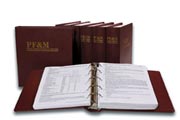 |
 |
 |
|
PF&M at a Glance Insurance for truckers and motor Trucks handle most of the cargo and freight shipments made in the United States. Goods can be shipped in owners’ vehicles by contract carriers or by common carriers. The Insurance Services Office (ISO) provides three different coverage forms for these vehicles. The Business Auto Coverage Form can be used for all three situations but is most often used when owners ship their own goods in their own vehicles. Common carriers can use any of the three forms, while contract carriers can use either the Business Auto or Motor Carrier Coverage Forms but not the Truckers Coverage Form. The Truckers and Motor Carrier Coverage Forms provide unique coverages not found in the Business Auto Coverage Form. The ISO Truckers Coverage Form CA 00 12 is designed for truckers hauling goods for a fee subject to government regulation while operating over designated routes or in a territory authorized and approved by a government regulatory authority. This form was developed before deregulation of the motor transportation industry. It is still used today, primarily by common carriers. The ISO Motor Carrier Coverage Form CA 00 20 is designed for the current regulatory climate. The key component of deregulation was the change in the relationship between carriers and their customers. This form encourages greater negotiation in arranging shipping contracts. It uses contracts and other written agreements between the parties to clarify who is an insured, instead of regulatory trucking language, making it flexible enough to work in almost any carrier-for-hire situation. There are three key differences between the Trucker/Motor Carrier forms and the Business Auto form: 1. Who Is An Insured. This is an area of major difference in coverage and is one of the reasons that truckers and motor carriers need a unique form. In addition to the entities named as insureds under the Business Auto form, both the motor carrier and truckers forms can add and remove parties. An example is owners of hired vehicles. If a non-owned trailer is used exclusively for the named insured’s business, or if the trailer is connected to a covered vehicle, the trailer owner becomes an insured. In another case, if a non-owned vehicle other than a trailer is leased to the insured without a hold harmless agreement to benefit the named insured, the lessor of that vehicle is also an insured. Groups not included under the Truckers and Motor Carrier forms are any carriers that meet their financial responsibility obligations in ways other than using liability insurance or that do not have insurance on hired autos for the protection of the owner of the vehicles on a primary basis. In addition, rail, water and air carriers assisting in the transport of vehicles are not insureds when a covered trailer is being loaded, transported or unloaded and is not attached to the power unit. 2. Other Insurance Clause. Under the Business Auto form, the party that owns the vehicle provides the primary liability coverage. Since truckers and motor carriers regularly hire independent owner/operators, these specialized forms provide that the insured’s coverage is primary and the hired vehicle coverage is excess in these cases. Similarly, the insured’s coverage is excess over the coverage provided by the hiring carrier when the insured leases a vehicle to another motor carrier. Under Truckers coverage, the insured must be operating under regulatory authority. Under Motor Carrier coverage, the relationship and responsibilities are established through contracts between the parties. 3. Trailer Interchange is the physical damage version of the Other Insurance Clause for the specialized Trucking forms. The insurer agrees to pay amounts for which the insured becomes liable as a result of damages to a non-owned trailer and its equipment when the trailer and its equipment is in the care of, or is used by, the insured. The primary difference between the Truckers Coverage Form and the Motor Carriers Coverage Form is regulation vs. contract. The Truckers Coverage Form refers specifically to the insured’s business as a trucker and to the operating rights granted by a public authority. The Motor Carrier Coverage Form does not refer to the operation or the operating rights granted by a public authority but looks to the contractual relationship between the insured and its clients. Underwriting and rating is based on evaluation of a number of fairly familiar criteria. Zone rating is unique and important because it applies to trucks that regularly operate over 200 miles from their principal garaging location. These vehicles are considered “long-haul” and are rated based on metropolitan or geographic “zones” where they travel. This is an established system of zones based on the origination and destination points of travel. Of course, drivers are always the most important component and represent the area most evaluated and of greatest concern. Please note that this is only a brief overview of the coverages available in these programs. The PF&M Analysis from The Rough Notes Company, Inc., contains broader and more thorough discussions of these and other related subjects. Agency OnLine subscribers can refer to PF&M Sections 220.4-2, Business Auto Coverage Form Analysis, 223.4-2, Truckers Coverage Form Analysis and 224.4-2, Motor Carrier Coverage Form Analysis for detailed evaluations, discussions and additional information on these and other related subjects. * |
|
|||||||||||||
| ||||||||||||||
